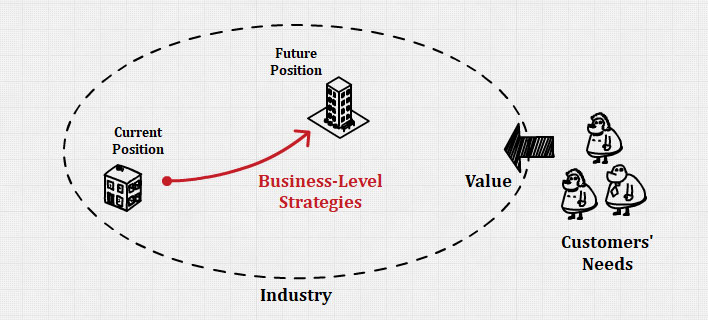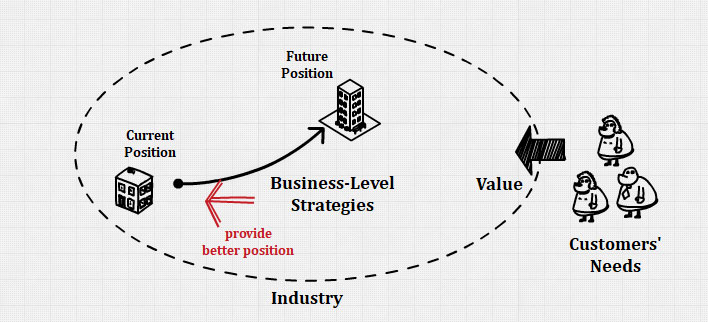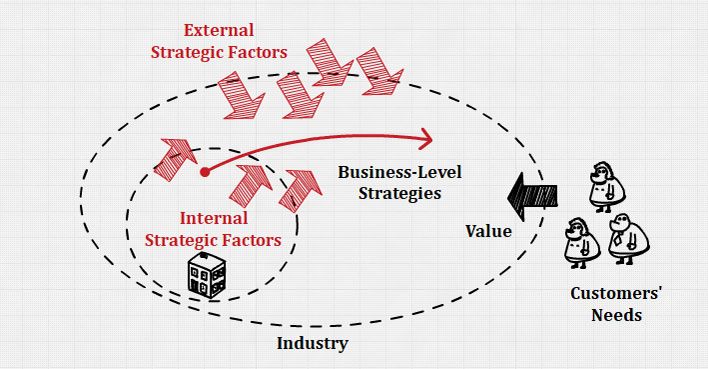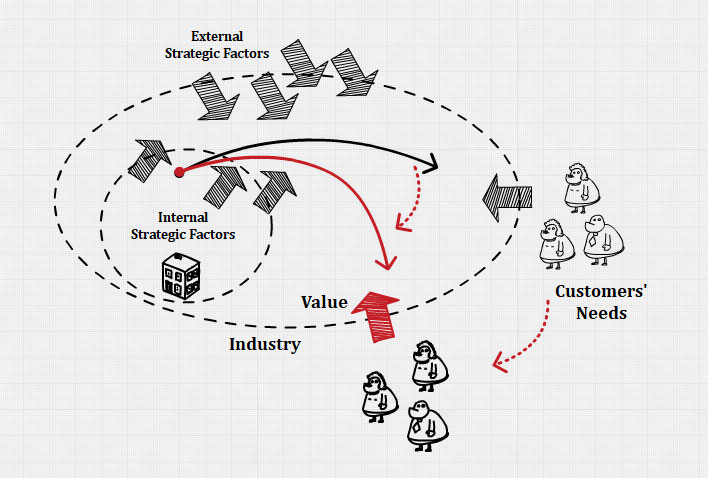What is Business-Level Strategy?

A business-level strategy indicates the choices the firm has made about how it intends to compete in an industry.
Increasingly important to firm success, a strategy is concerned with making choices among two or more alternatives. When choosing a strategy, the firm decides to pursue one course of action instead of others. These choices are important because a firm’s strategies directly link to its long-term performance.
Business-level strategies are purposeful, precede the taking of actions to which they apply, and demonstrate a shared understanding of the firm’s vision and mission. A properly developed strategy rationalizes the firm’s vision and mission along with the actions taken to achieve them.
A business-level strategy focuses on improving the competitive position of a company within a specific industry that it serves. Business-level strategy is important because it is a massive boost to the overall company performance.
Every firm, ranging from the local dry cleaner to the multinational corporation, must develop and use at least one business-level strategy.
Thus a business-level strategy is the core strategy, which is the strategy that the firm forms to describe how it intends to compete in a product market.
A firm competing in a single-product market in a single geographic location does not need a corporate-level strategy regarding product diversity or an international strategy to deal with geographic diversity. In contrast, a diversified firm will use one of the corporate-level strategies as well as a separate business-level strategy for each product market in which it competes.
There are 2 types of business-level strategies: competitive strategies and cooperative strategies.
Business-level strategy can be competitive, as in battling against competitors for advantage, or cooperative, as in working with other companies to gain advantage against other competitors, or it can be both competitive and cooperative.
The Purpose of a Business-Level Strategy

The fundamental purpose of a business-level strategy is to create differences between the firm’s position and those of its competitors.
Having formulated a proper business-level strategy, a firm can gain strategic competitiveness and earn above-average returns. Thus, a firm must find the best way to position itself against its rivals in the industry. A business-level strategy is a tool for the company to achieve this goal.
How to Create a Business-Level Strategy?

To create a business-level strategy is to create a plan of action that marshals, integrates, and allocates the firms’ internal strategic factors so that they can be properly aligned with its external strategic factors, thus gain a competitive advantage over its rivals.
Simply put, the plan of action is influenced by opportunities and threats in the firm’s external environment as well as the nature and quality of the resources, capabilities, and core competencies in its internal organization.
In the current complex competitive landscape, successful use of a business-level strategy results from the firm learning how to integrate the activities it performs along a value chain and create superior value propositions for customers. To position itself differently from competitors, a firm must decide whether it intends to perform activities differently or to perform different activities.
Strategic fit among these activities is critical for competitive advantage. It is more difficult for a competitor to match a configuration of integrated activities than to imitate a particular activity such as sales promotion, or process technology.
There are 3 decisions involved when creating a business-level strategy.
The firm needs to determine: (1) who will be served, or what is to be satisfied; (2) what needs those target customers have that it will satisfy, or who is to be satisfied; and (3) distinctive competencies, or how those customer needs are to be satisfied.
Customers: The Foundation of Business-Level Strategies

Importance of Customers
Customers are the foundation of successful business-level strategies.
Selecting customers and deciding which of their needs the firm will try to satisfy, as well as how it will do so, are challenging tasks.
A key reason why firms must satisfy customers with their business-level strategy is that returns earned from relationships with customers are the lifeblood of all organizations. The most successful companies must always try to find new ways to satisfy current customers and/or to meet the needs of new customers.
Competition has created many attractive options for customers, thus making it difficult to determine the business-level strategy to best serve them. Effective competitors have become adept at identifying the needs of customers as well as learning how to quickly and successfully adapt the functionality of a firm’s goods or services to meet those needs.
Strategic competitiveness results only when the firm satisfies a group of customers by using its competitive advantages as the basis for competing in a market.
Effectively Managing Relationships with Customers
The firm’s relationships with its customers are strengthened when it delivers superior value to them.
Strong interactive relationships with customers often provide the foundation for the firm’s efforts to profitably serve customers’ unique needs.
Importantly, delivering superior value often results in increased customer satisfaction. In turn, customer satisfaction has a positive relationship with profitability because satisfied customers are most likely to be repeat customers.
However, more choices and easily accessible information about the functionality of the firms’ products are creating increasingly sophisticated and knowledgeable customers, making it difficult to earn their loyalty. As such, many firms are working with customers to co-create value through working closely together to ensure customer satisfaction.
The relationship between a firm and its customers is characterized by 3 dimensions: reach, richness, and affiliation.
Effectively managing customer relationships (along the dimensions of reach, richness, and affiliation) helps the firms answer questions related to the issues of which customers to serve, and what needs of those customers are to be satisfied.
Dimension 1: Reach
The reach dimension of relationships with customers is concerned with the firm’s access and connection to customers. In general, firms seek to extend their reach, adding customers in the process of doing so.
Dimension 2: Richness
Richness, the second dimension of firms’ relationships with customers, is concerned with the depth and detail of the two-way flow of information between the firm and the customer.
The potential of the richness dimension to help the firm establish a competitive advantage in its relationship with customers leads many firms to offer online services in order to better manage information exchanges with their customers.
Broader and deeper information-based exchanges allow firms to better understand their customers and their needs. Such exchanges also enable customers to become more knowledgeable about how the firm can satisfy them.
Internet technology and e-commerce transactions have substantially reduced the costs of meaningful information exchanges with current and potential customers.
Dimension 3: Affiliation
Affiliation, the third dimension, is concerned with facilitating useful interactions with customers. Viewing the world through the customer’s eyes and constantly seeking ways to create more value for the customer have positive effects in terms of affiliation.
This approach enhances customer satisfaction and produces fewer customer complaints. In fact, for services, customers often do not complain when dissatisfied; instead, they simply go to competitors for their service needs, although a firm’s strong brand can mitigate the switching.
Likewise, because of data available through digitization, firms have a tremendous amount of individual customer data, and this data-gathering trend is growing, allowing firms to customize their products and services.
Determining Customer Needs and Market Segmentation
Customer needs are desires, wants, or cravings that can be satisfied by means of the characteristics of a product (a good or service).
Finding who the target customer is and what their needs are that the firm intends to serve with its business-level strategy is an important decision. In order to make this decision, companies divide their target customers into groups based on differences in the customer’s needs. This is called market segmentation.
Thus, market segmentation is a process used to cluster people with similar needs into individual and identifiable groups.
Almost any identifiable human or organizational characteristic can be used to sub-divide a market into segments that differ from one another on a given characteristic.
Market segmentation is the way a company decides to group customers, based on important differences in their needs or preferences, in order to gain a competitive advantage.
In general, a company can adopt one of three alternative strategies for market segmentation.
First, it can choose not to recognize that different groups of customers have different needs and can instead adopt the approach of serving the average customer.
Second, a company can choose to recognize the differences between customer groups and make a product targeted toward most or all of the different market segments.
Providing many products for many market segments allows a company to satisfy customers’ needs better. As a result, customer demand for a company’s products rises and generates more revenue than would be the case if the company offered just one product for the whole market.
Third, a company can choose to recognize that the market is segmented but concentrate on servicing only one market segment.
Sometimes, the nature of the market does not allow much segmentation.
In these industries, there is little opportunity to obtain a competitive advantage through market segmentation, because there is little opportunity for serving customers’ needs and customer groups in different ways
Instead, price is the main criterion that customers use to evaluate the product, and the competitive advantage lies with the company that has superior efficiency and can provide the lowest-priced product.
Following the practice of market segmentation, often depending on the nature of the market, firms will be able to locate a niche, and more favorably, a propitious niche.
Market Niche & Propitious Market Niche
A niche is a need in the marketplace that is currently unsatisfied.
A propitious niche is an extremely favorable niche that is well suited to the organization’s internal and external environment that other corporations are not likely to challenge or dislodge. The niche is propitious to the extent that it is currently just large enough for one firm to satisfy its demand.
After the firm has found and filled that niche, it is not worth the time, effort, and resources for potential competitors to pursuit that same niche. Such a niche may also be called a strategic sweet spot, where an organization can satisfy customer’s needs in a way that rivals cannot, given the context in which it operates.
Management must look for a strategic window in order to determine a propitious niche. This window is a unique market opportunity that is available only for a particular time. The organization can occupy this niche through the strategic window, given they have sufficient strengths or don’t have weaknesses that competitors possess. In other words, the organization has a distinctive competency that allows them to be the best fit for that niche, among all competition.
The key is to identify a market opportunity in which the first firm to reach that market segment can obtain and keep a dominant market share. As the niche grows, so can the organization within that niche, whether through expanding its operations capacity or through partnerships and alliances with larger firms.
The niche can also evolve, sometimes faster than the company can adapt to it. Management needs to do situation analysis and discover that they need to invest heavily in the organization’s capabilities and resources to stay competitive in that niche.
Determining Which Customer Needs the Firm Can Satisfy
After the firm decides who it will serve, it must identify the targeted customer group’s needs that its goods or services can satisfy. In a general sense, needs are related to a product’s benefits and features.
Successful firms learn how to deliver to customers what they want, when, and where they want it. Having close and frequent interactions with both current and potential customers helps the firm identify those individuals’ and groups’ current and future needs.
From a strategic perspective, a basic need of all customers is to buy products that create value for them. The generalized forms of value that goods or services provided are either low cost with acceptable features or highly differentiated features with acceptable cost.
The most effective firms continuously strive to anticipate changes in customers’ needs. A firm that fails to anticipate and certainly recognize changes in its customers’ needs may lose its customers to competitors whose products can provide more value to the focal firm’s customers.
Unhappy consumers lead to lost sales, both theirs and those of others who learn of their dissatisfaction. Therefore, it is important to maintain customer satisfaction by carefully selecting, meeting, and satisfying their needs.
Determining Core Competencies Necessary to Satisfy Customer Needs
In creating and selecting business-level strategy choices, a company must decide how to organize and combine its distinctive competencies to gain a competitive advantage.
After deciding who the firm will serve and the specific needs of those customers, the firm is prepared to determine how to use its capabilities and competencies to develop products that can satisfy the needs of its target customers.
Core competencies are resources and capabilities that serve as a source of competitive advantage for the firm over its rivals. Firms use core competencies to implement business-level strategies, thereby satisfying customers’ needs.
Only those firms with the capacity to continuously improve, innovate, and upgrade their competencies can expect to meet and hopefully exceed customers’ expectations across time.
Firms must continuously upgrade their capabilities to ensure that they maintain an advantage over their rivals by providing customers with superior products. Often these capabilities are difficult for competitors to imitate, partly because they are constantly being upgraded, but also because they are integrated and used as configurations of capabilities to perform an important activity.
Many types of firms now emphasize innovation, not only those in high technology industries. This innovation appears to be driven by customers, along with providing a product or service that satisfies their customers’ needs in a manner superior to that of rivals’ products or services to gain or sustain a competitive advantage.
Resources
Further Reading
- Why is a business level strategy important? (talentedge.com)
- What is Business Level Strategy? (tracktime24.com)
- Business Level Strategy (getsling.com)
- Business-Level Strategy (businessjargons.com)
- Business-Level Strategy (baturseker.medium.com)
- Business Level Strategy Vs. Corporate Level Strategy (bizfluent.com)
- Discover the 5 Different Types of Business-Level Strategies (become.co)
- What is Business Level Strategy? A complete guide for beginners (avada.io)
- What is Business Level Strategy? (freemean.com)
Even More Reading
- Business Level Strategy: Know How To Implement Business Level Strategies (capitalbay.news)
- What Is Business Strategy? – Components, Levels, & Examples (feedough.com)
- Business-Level Strategy (wisdomjobs.com)
- Business-Level Strategies (mbaknol.com)
- What Is Business Level Strategy? (profiletree.com)
Related Concepts
References
- Hill, C. W. L., & Jones, G. R. (2011). Essentials of Strategic Management (Available Titles CourseMate) (3rd ed.). Cengage Learning.
- Mastering Strategic Management. (2016, January 18). Open Textbooks for Hong Kong.
- Wheelen, T. L. (2021). Strategic Management and Business Policy: Toward Global Sustainability 13th (thirteenth) edition Text Only. Prentice Hall.